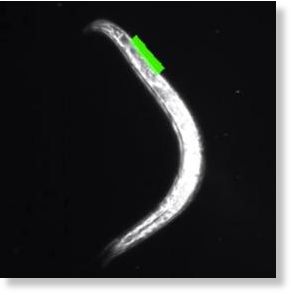Scientists have come a step closer to gaining complete control over a mind, even if that mind belongs to a creature the size of a grain of sand. A team at Harvard University has built a computerized system to manipulate worms - making them start and stop, giving them the sensation of being touched, and even prompting them to lay eggs, as seen in the video above - by stimulating their neurons individually with laser light, all while the worms swim freely in a petri dish. The technology may help neuroscientists for the first time gain a complete understanding of the workings of an animal's nervous system.
The worm in question, Caenorhabditis elegans, is one of the most extensively studied organisms in biology: researchers have completely mapped and classified its cells - each individual has exactly 1,031 - including its 302 neurons and the 5,000 or so connections among them. But science still does not know exactly "how neurons work together in a network," says Andrew Leifer, a graduate student in biophysics at Harvard, For example, how does the worm coordinate its 100 or so muscles to relax and contract in a wave pattern as the worm swims?
Inducing a worm to lay eggs with laser light from Samuel Lab on Vimeo.
To find out, Leifer and his collaborators genetically engineered the one-millimeter-long nematode worm to make particular cells in its body sensitive to light, a technique called optogenetics, developed in recent years by Stanford University psychiatrist and bioengineer Karl Deisseroth [see Deisseroth's Controlling the Brain with Light, Scientific American, November 2010]. Because the worm's body is transparent, sharply focused lasers, pointed with an accuracy of 30 microns, could turn on or suppress individual neurons with no need for electrodes or other invasive methods. Leifer placed a microscope on a custom-built stage to track the worm as it swam around in a dish. He also wrote software that analyzed the microscope's images to locate the target neurons, and then pointed and fired the lasers accordingly - all at a rate of 50 frames per second. The results were published online January 16 in Nature Methods (Scientific American is part of Nature Publishing Group).
Other teams have performed optogenetic studies and controlled individual neurons on immobilized worms. But, to understand the organism's physiology, says Leifer, it is necessary to manipulate it as it swims freely. He and his collaborators were able to show, for example, that during swimming, motor signals move down the body through muscle cells themselves as well as through nerve connections, by selectively blocking sections of its musculature and nervous system. In the video below, one can see the worm stopping as laser light inhibits motor neurons in the front of its body
Disrupting locomotion by inhibiting motor neurons of a worm with laser light from Samuel Lab on Vimeo.
The team also tested its technology's potential by making a worm lay eggs and by showing that a particular neuron processes information from touch-sensing cells. In the video below, blue laser light induces a sensation of touch by stimulating those cells, and the worm, sensing that it has bumped into some object, reverses course.
Stimulating a worm's anterior touch receptors (AVM and ALM) with laser light from Samuel Lab on Vimeo.
The technique ""greatly enhances the capabilities for optogenetic control"" in worms, says Deisseroth.Leifer hopes it could some day help scientists create complete simulations of the organism's behavior. "Hopefully, we'll be able to make a computational model of the entire nervous system," he says. In a way, that would be like "uploading a mind," though a rudimentary one.




The brain is the body, not the mind. The brain is not the mind. Until we understand that, we are just machines. And the PTB are learning more and more how to steer it.